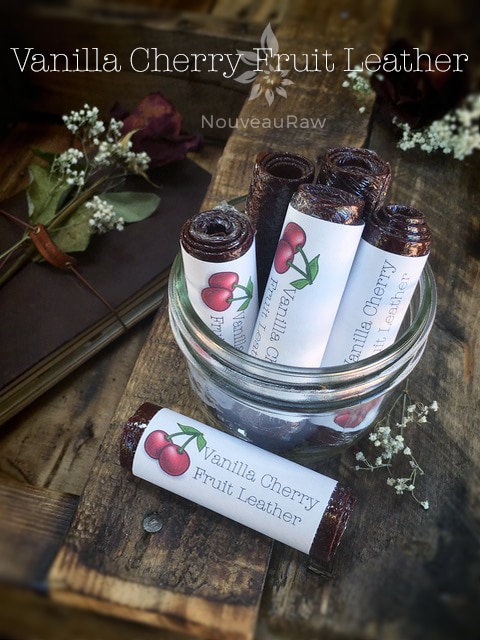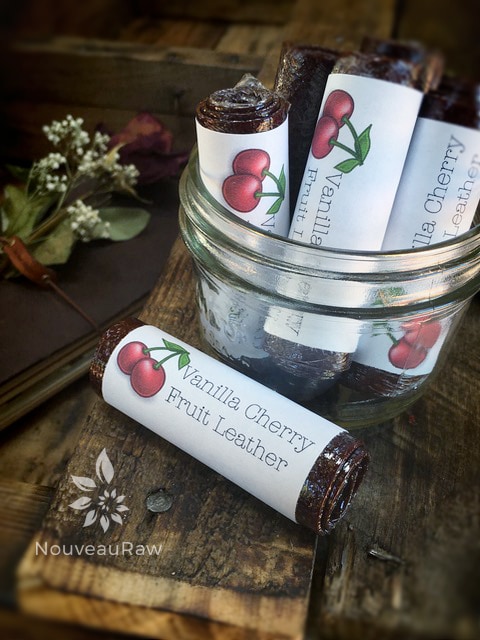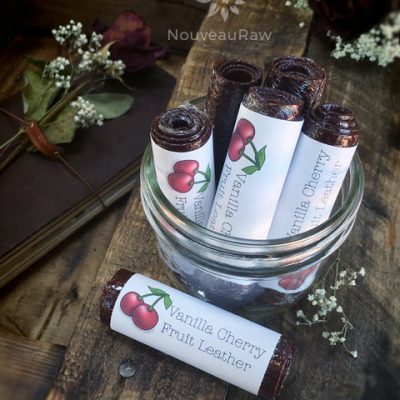Vanilla Cherry Fruit Leather

 Add to favorites
Add to favorites

~ raw, vegan, gluten-free, nut-free ~
Fruit leathers are an equal opportunity for food. It doesn’t matter what your age is, what you look like, what color your skin is, how tall or short you may be, if you are having a bad hair day or not… it just doesn’t matter. It’s all good.
They are great for moms on the go, an afternoon snack for the kids as they come bounding off the school bus, a quick pick-me-upper snack to have before the evening Boy Scout or Girl Scout meeting, for those who get stuck in a business meeting and you need to hush your growling stomach, so the whole group doesn’t look at you.
Take a breath, Amie Sue…
a great way to keep up your stamina as you power shop at the mall for that “perfect outfit”, for the nurse who gets a 10-minute break before the double shift starts, and last but not least… for the husband who is continually rummaging through the kitchen cabinets looking for “that” flavor.
There is no wrong way to eat fruit leather; grab firmly and rip off a bit “cave-man” style! Peel thin strips, tilt your head back and slowly lower the strip in your mouth, roll pieces into a ball and try to toss it into your partner’s mouth, suck on a piece and let it dissolves on the roof of your mouth, or eat at your leisure as you lounge on the deck with your feet kicked up, fold strips into triangle shapes, roll into a cylinder and use as a straw in your favorite drink, lend your imagination to the fruit leather and just enjoy it. :)
Key points to remember when making your own fruit leathers. Don’t add any sweetener until you have pureed all the other ingredients together. If the fruit is ripe enough, it may not need any help. Keep in mind; flavors intensify during the dehydration process. When storing, make sure you wrap it well in plastic wrap. Fruit leather will stick…meld….fuse to itself. :) Now go on, hop into that kitchen of yours and get busy.
 Ingredients:
Ingredients:
yields 4 1/2 cups
- 5 cups organic cherries (I used Bing), washed and pitted
- 1 Tbsp + 1 tsp vanilla extract
- 1 Tbsp fresh lemon juice
Preparation:
- Select RIPE or slightly overripe cherries that have reached a peak in color, texture, and flavor.
- Prepare the cherries; wash, dry, remove stems, and pits.
- Puree the fruit, vanilla, and lemon juice in your blender or food processor until smooth.
- Taste and sweeten if needed. Keep in mind that flavors will intensify as they dehydrate.
- When adding a sweetener do so 1 tbsp at a time, and reblend, tasting until it is at the desired taste.
- It is best to use a liquid type sweetener such as raw honey or maple syrup as an example. Don’t use granulated sugar because it tends to change the texture of the finished fruit leather.
- Problem: The puree for the fruit leather is too thick (won’t pour easily). Add fruit juice or water, a little at a time until the right consistency. Also, you can add other fruits that are higher in water content.
- Problem: The puree for the fruit leather is too thin (too runny). Mix with fruit that has a lower water content such as banana or add 1 Tbsp at a time of ground chia seeds.
- Spread the fruit puree on teflex sheets that come with your dehydrator. Pour the puree to create an even depth of 1/8 to 1/4 inch. If you don’t have teflex sheets for the trays, you can line your trays with plastic wrap or parchment paper. Do not use wax paper or aluminum foil.
- Lightly coat the food dehydrator plastic sheets or wrap with a cooking spray, I use coconut oil that comes in a spray.
- When spreading the puree on the liner, allow about an inch of space between the mixture and the outside edge. The fruit leather mixture will spread out as it dries, so it needs a little room to allow for this expansion.
- Be sure to spread the puree evenly on your drying tray. When spreading the puree mixture, try tilting and shaking the tray to help it distribute more evenly. Also, it is a good idea to rotate your trays throughout the drying period. This will help assure that the leathers dry evenly.
- Dehydrate the fruit leather at 145 degrees (F) for one hour, reduce temp to 115 degrees (F) and continue drying for about 16 (+/-) hours. The finished consistency should be pliable and easy to roll.
- Check for dark spots on top of the fruit leather. If dark spots can be seen it is a sign that it is not completely dry.
- Press down on the fruit leather with a finger. If no indentation is visible or if it is no longer tacky to the touch, the fruit leather is dry and can be removed from the dehydrator.
- Peel the leather from the dehydrator trays or parchment paper. If it peels away easily and holds its shape after peeling, it is dry. If it is still sticking or loses its shape after peeling, it needs further drying.
- Under-dried fruit leather will not keep; it will mold. Over-dried fruit leather will become hard and crack, although it will still be edible and will keep for a long time.
- Storage: To store the finished fruit leather…
- Allow the leather to cool before wrapping to avoid moisture from forming, which makes a breeding ground for molds.
- Roll them up and wrap them tightly with plastic wrap. Click (here) to see photos of how I wrap them.
- Place in an air-tight container, and store in a dry, dark place. (Light will cause the fruit leather to discolor.)
- The fruit leather will keep at room temperature for one month, or in a freezer for up to one year.
Culinary Explanations:
- Why do I start the dehydrator at 145 degrees (F)? Click (here) to learn the reason behind this.
- When working with fresh ingredients, it is important to taste test as you build a recipe. Learn why (here).
- Don’t own a dehydrator? Learn how to use your oven (here). I do however truly believe that it is a worthwhile investment. Click (here) to learn what I use.
© AmieSue.com
Tags: Dairy Free, Gluten Free, Nut Free, Refined Sugar Free, Soy Free, sugar free, Vegan



 Add to favorites
Add to favorites
 Ingredients:
Ingredients: